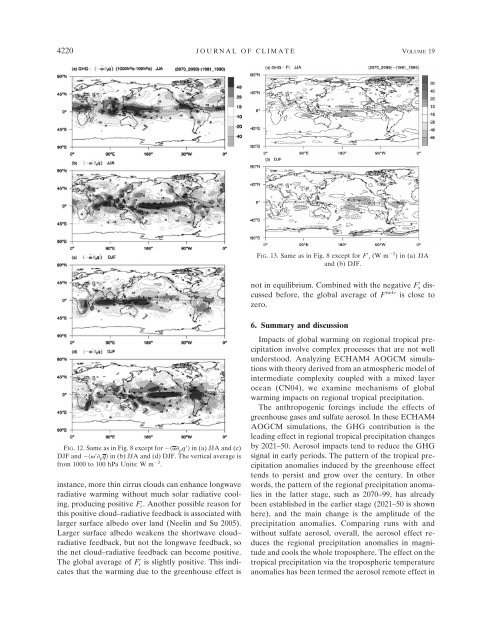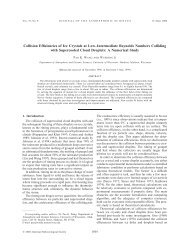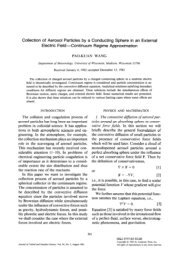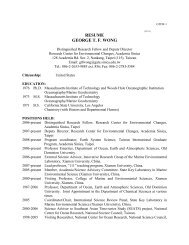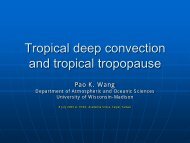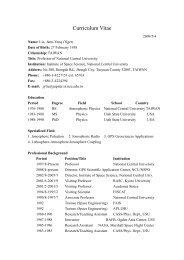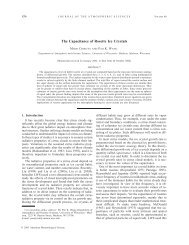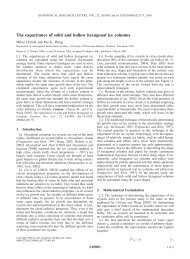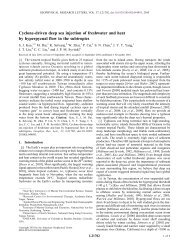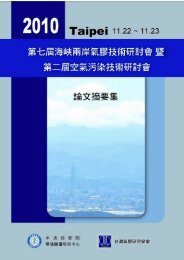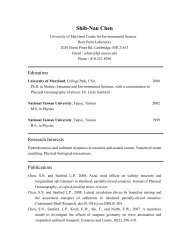Regional Tropical Precipitation Change ... - Academia Sinica
Regional Tropical Precipitation Change ... - Academia Sinica
Regional Tropical Precipitation Change ... - Academia Sinica
You also want an ePaper? Increase the reach of your titles
YUMPU automatically turns print PDFs into web optimized ePapers that Google loves.
4220 JOURNAL OF CLIMATE VOLUME 19<br />
FIG. 13. Same as in Fig. 8 except for F t (W m 2 ) in (a) JJA<br />
and (b) DJF.<br />
not in equilibrium. Combined with the negative F s discussed<br />
before, the global average of F net is close to<br />
zero.<br />
FIG. 12. Same as in Fig. 8 except for p q in (a) JJA and (c)<br />
DJF and p q in (b) JJA and (d) DJF. The vertical average is<br />
from 1000 to 100 hPa Units: W m 2 .<br />
instance, more thin cirrus clouds can enhance longwave<br />
radiative warming without much solar radiative cooling,<br />
producing positive F t . Another possible reason for<br />
this positive cloud–radiative feedback is associated with<br />
larger surface albedo over land (Neelin and Su 2005).<br />
Larger surface albedo weakens the shortwave cloud–<br />
radiative feedback, but not the longwave feedback, so<br />
the net cloud–radiative feedback can become positive.<br />
The global average of F t is slightly positive. This indicates<br />
that the warming due to the greenhouse effect is<br />
6. Summary and discussion<br />
Impacts of global warming on regional tropical precipitation<br />
involve complex processes that are not well<br />
understood. Analyzing ECHAM4 AOGCM simulations<br />
with theory derived from an atmospheric model of<br />
intermediate complexity coupled with a mixed layer<br />
ocean (CN04), we examine mechanisms of global<br />
warming impacts on regional tropical precipitation.<br />
The anthropogenic forcings include the effects of<br />
greenhouse gases and sulfate aerosol. In these ECHAM4<br />
AOGCM simulations, the GHG contribution is the<br />
leading effect in regional tropical precipitation changes<br />
by 2021–50. Aerosol impacts tend to reduce the GHG<br />
signal in early periods. The pattern of the tropical precipitation<br />
anomalies induced by the greenhouse effect<br />
tends to persist and grow over the century. In other<br />
words, the pattern of the regional precipitation anomalies<br />
in the latter stage, such as 2070–99, has already<br />
been established in the earlier stage (2021–50 is shown<br />
here), and the main change is the amplitude of the<br />
precipitation anomalies. Comparing runs with and<br />
without sulfate aerosol, overall, the aerosol effect reduces<br />
the regional precipitation anomalies in magnitude<br />
and cools the whole troposphere. The effect on the<br />
tropical precipitation via the tropospheric temperature<br />
anomalies has been termed the aerosol remote effect in


